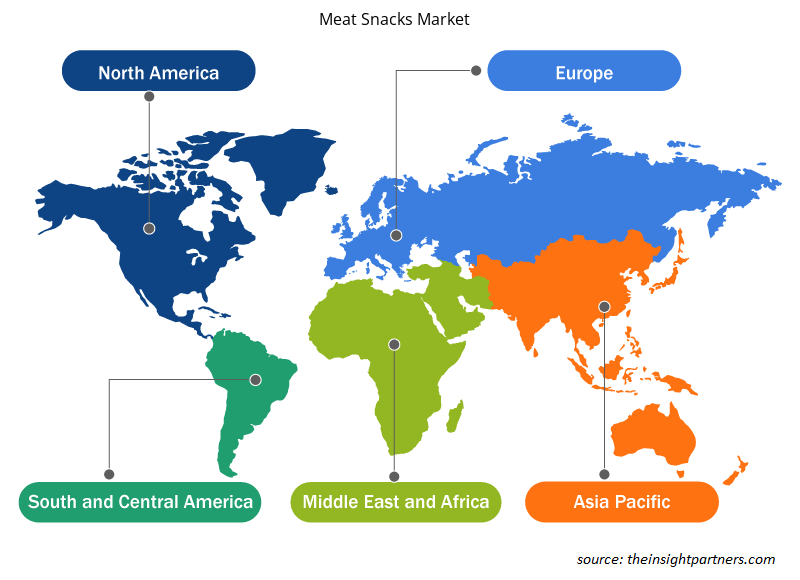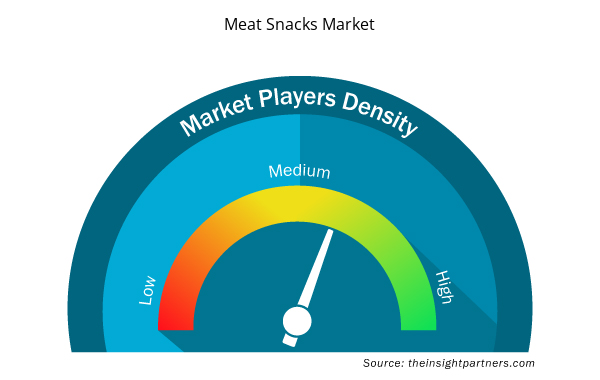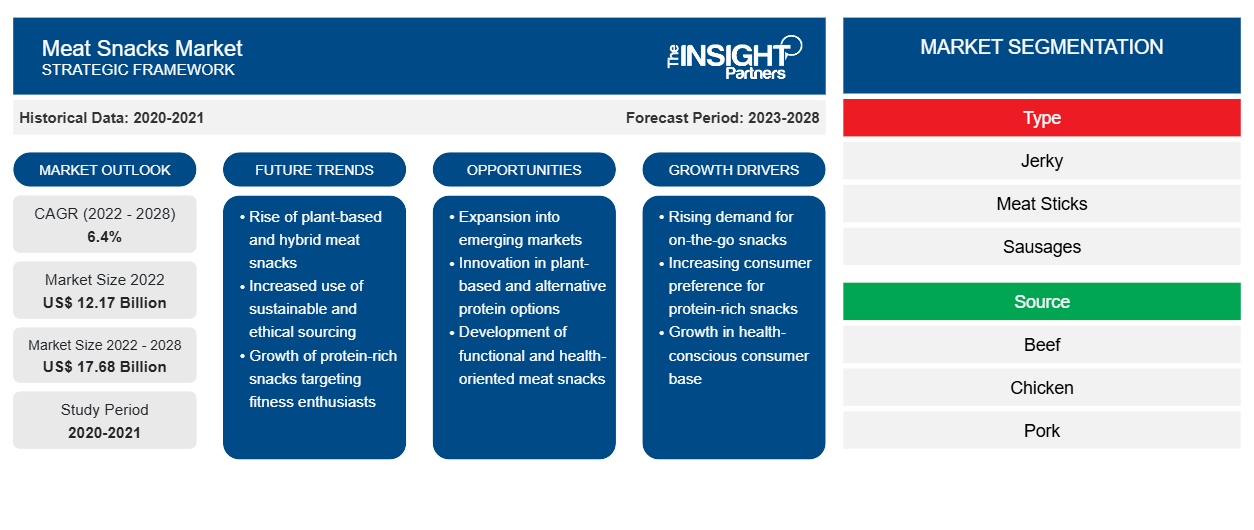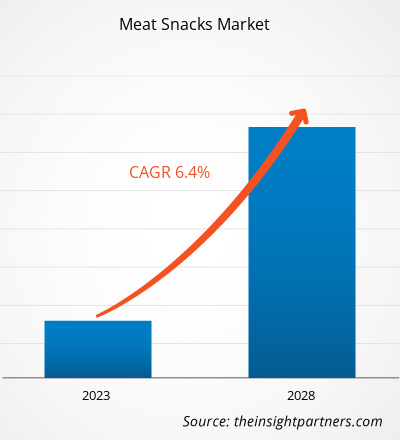[Rapporto di ricerca] Si prevede che le dimensioni del mercato degli snack a base di carne cresceranno da 12.169,01 milioni di dollari nel 2022; si stima che crescerà a un CAGR del 6,4% dal 2022 al 2028
Gli snack a base di carne stanno riscuotendo un enorme successo tra i consumatori, in quanto sono ricchi di proteine, ferro, creatina e diverse vitamine. Inoltre, sono disponibili in una varietà di sapori dolci e salati, il che ne aumenta la domanda tra i consumatori. Attualmente, la maggior parte degli snack a base di carne disponibili sul mercato sono realizzati con manzo o maiale. Tuttavia, con l'aumento delle preoccupazioni per la salute e il benessere, le persone si stanno spostando verso fonti più magre di proteine animali. Manzo, maiale e agnello contengono un contenuto di grassi saturi più elevato rispetto al pollo. A causa della crescente prevalenza di obesità e malattie cardiache, i consumatori preferiscono prodotti a base di carne a basso contenuto di grassi. Questo fattore sta guidando la domanda di snack a base di carne di pollo tra i consumatori.
Nel 2021, il Nord America ha detenuto la quota maggiore del mercato degli snack di carne , mentre si stima che l'Asia Pacifica registrerà il CAGR più elevato durante il periodo di previsione. La carne di pollame e di maiale sono carni ampiamente consumate in tutta l'Asia Pacifica. Secondo il National Bureau of Statistics, la produzione di carne di maiale in Cina è aumentata al 35,9% nel 2021 rispetto all'anno precedente. Inoltre, l'industria avicola sta crescendo rapidamente in Cina, India, Giappone e altri paesi dell'Asia Pacifica, poiché la domanda di carne di pollame sta aumentando in modo significativo. Si prevede che questi fattori guideranno la crescita del mercato degli snack di carne in tutta l'Asia Pacifica nel periodo di previsione.
Personalizza questo report in base alle tue esigenze
Riceverai la personalizzazione gratuita di qualsiasi report, comprese parti di questo report, o analisi a livello nazionale, pacchetto dati Excel, oltre a usufruire di grandi offerte e sconti per start-up e università
- Scopri le principali tendenze di mercato in questo rapporto.Questo campione GRATUITO includerà analisi di dati che spaziano dalle tendenze di mercato alle stime e alle previsioni.
Impatto della pandemia di COVID-19 sul mercato degli snack di carne
Il settore alimentare e delle bevande ha dovuto affrontare sfide inaspettate a causa della pandemia di COVID-19. Le restrizioni governative, come i lockdown , le chiusure della produzione, i divieti di viaggio e le restrizioni alle frontiere, hanno interrotto le catene di fornitura globali nel 2020. Le interruzioni nelle operazioni di produzione e approvvigionamento delle materie prime hanno ostacolato la crescita del mercato degli snack di carne durante i primi mesi della pandemia. Tuttavia, la domanda di snack di carne congelati è aumentata durante questa crisi globale a causa degli acquisti di panico da parte dei consumatori. I consumatori in paesi come Stati Uniti, Canada, Germania e Regno Unito sono passati drasticamente a una dieta a base vegetale. Secondo una ricerca della Vegan Society, un britannico su cinque ha ridotto il consumo di carne dall'inizio della pandemia. Questo fattore ha ostacolato la domanda di snack di carne. Nel 2021, il mercato ha assistito a una ripresa, poiché i governi hanno annunciato un allentamento delle restrizioni precedentemente imposte e hanno consentito ai produttori di lavorare a piena capacità. Pertanto, l'aumento dei volumi di produzione e il miglioramento delle operazioni della catena di fornitura hanno rafforzato la crescita del mercato degli snack di carne. La pandemia ha avuto un impatto misto sul mercato globale degli snack di carne.
Approfondimenti di mercato
Sviluppi strategici da parte dei principali attori del mercato per guidare il mercato degli snack di carne durante il periodo di previsione
Le aziende stanno ampliando le loro capacità produttive per soddisfare la crescente domanda di snack a base di carne in tutto il mondo. Ad esempio, nell'aprile 2022, Jack Link's, uno dei principali marchi di snack a base di carne negli Stati Uniti, ha investito 450 milioni di dollari per costruire un nuovo stabilimento di produzione in Georgia. Analogamente, nel luglio 2020, Conagra Brands ha investito 100 milioni di dollari per espandere il suo stabilimento di produzione di snack a base di carne in Ohio, Stati Uniti, per soddisfare la crescente domanda di prodotti a base di carne Slim Jim e salsicce affumicate Duke's. Si prevede che tali strategie guideranno in modo significativo la crescita del mercato degli snack a base di carne durante il periodo di previsione.
Tipo Informazioni
In base al tipo, il mercato degli snack di carne è suddiviso in carne secca, bastoncini di carne, salsicce e altri. Il segmento della carne secca ha detenuto la quota maggiore del mercato nel 2021. Tuttavia, si prevede che il segmento dei bastoncini di carne registrerà il CAGR più elevato dal 2022 al 2028. I jerky sono gli snack di carne più popolari. I produttori stanno sviluppando versioni più sane di snack di carne secca per soddisfare le crescenti preoccupazioni per la salute dei consumatori. Ad esempio, a settembre 2019, la Werner Gourmet Meat Snacks con sede negli Stati Uniti, un produttore di carne secca e snack, ha lanciato un nuovo prodotto nella categoria degli snack di carne con una carne secca senza zucchero realizzata con carne di manzo nutrita con erba. Si prevede che tali prodotti acquisiranno un'enorme trazione tra i consumatori, il che alimenterà la crescita del mercato degli snack di carne durante il periodo di previsione.
Informazioni sulla fonte
In base alla fonte, il mercato degli snack di carne è segmentato in manzo, pollo, maiale e altri. Il segmento del manzo ha detenuto la quota di mercato maggiore nel 2021. Tuttavia, si prevede che il segmento del pollo registrerà il CAGR più elevato durante il periodo di previsione. Manzo, maiale e agnello contengono un contenuto di grassi saturi più elevato rispetto al pollo. Pertanto, un elevato consumo di manzo, maiale, agnello e altre carni con un elevato contenuto di grassi saturi aumenta il livello di colesterolo nel sangue, il che aumenta la vulnerabilità a malattie cardiache, obesità e ipertensione. Pertanto, i consumatori preferiscono sempre più prodotti a base di carne di pollo per soddisfare i requisiti proteici mantenendo basso il conteggio delle calorie. Si prevede che questo fattore guiderà la crescita del mercato nel segmento del pollo nei prossimi anni.
Informazioni sui canali di distribuzione
In base al canale di distribuzione, il mercato degli snack di carne è segmentato in supermercati e ipermercati, minimarket, vendita al dettaglio online e altri. Il segmento dei supermercati e degli ipermercati ha rappresentato la quota di mercato maggiore nel 2021, mentre si prevede che il mercato nel segmento della vendita al dettaglio online assisterà alla crescita più rapida durante il periodo di previsione. I negozi al dettaglio online offrono vari prodotti con forti sconti. Inoltre, i consumatori possono acquistare comodamente prodotti desiderabili da remoto tramite piattaforme di e-commerce, come Amazon.com, Walmart ed E-bay. I consumatori preferiscono sempre di più le piattaforme di vendita al dettaglio online per l'acquisto di snack di carne a causa della disponibilità di un'ampia gamma di prodotti di diversi marchi a prezzi scontati e della disponibilità di servizi di consegna a domicilio. Questo fattore sta guidando la crescita del mercato nel segmento della vendita al dettaglio online.
Tyson Foods Inc, Bridgford Foods Corporation, General Mills Inc, Werner Gourmet Meat Snacks, Premium Brands, Hormel Foods Corporation, Conagra Brands Inc, Link Snacks Inc, Country Archer Provisions e Organic Valley sono tra i principali attori che operano nel mercato degli snack di carne. Queste aziende si concentrano principalmente sull'innovazione di prodotto per espandere le dimensioni del loro mercato e soddisfare le tendenze emergenti del mercato. Ad esempio, a settembre 2020, Noel Alimentaria, un'azienda con sede in Spagna, ha lanciato snack di carne più salutari e da asporto con il marchio "Picalos". L'azienda ha adottato una tecnologia di produzione unica che disidrata lentamente e cuoce gli snack in modo artigianale e conserva le qualità nutrizionali della carne. Si prevede che tali prodotti riscuoteranno un grande successo tra i consumatori durante il periodo di previsione.
Approfondimenti regionali sul mercato degli snack di carne
Le tendenze regionali e i fattori che influenzano il mercato degli snack di carne durante il periodo di previsione sono stati ampiamente spiegati dagli analisti di Insight Partners. Questa sezione discute anche i segmenti e la geografia del mercato degli snack di carne in Nord America, Europa, Asia Pacifico, Medio Oriente e Africa e America meridionale e centrale.

- Ottieni i dati specifici regionali per il mercato degli snack di carne
Ambito del rapporto di mercato degli snack a base di carne
| Attributo del report | Dettagli |
|---|---|
| Dimensioni del mercato nel 2022 | 12,17 miliardi di dollari USA |
| Dimensioni del mercato entro il 2028 | 17,68 miliardi di dollari USA |
| CAGR globale (2022 - 2028) | 6,4% |
| Dati storici | 2020-2021 |
| Periodo di previsione | 2023-2028 |
| Segmenti coperti | Per tipo
|
| Regioni e Paesi coperti | America del Nord
|
| Leader di mercato e profili aziendali chiave |
|
Densità degli attori del mercato: comprendere il suo impatto sulle dinamiche aziendali
Il mercato degli snack di carne sta crescendo rapidamente, spinto dalla crescente domanda degli utenti finali dovuta a fattori quali l'evoluzione delle preferenze dei consumatori, i progressi tecnologici e una maggiore consapevolezza dei benefici del prodotto. Con l'aumento della domanda, le aziende stanno ampliando le loro offerte, innovando per soddisfare le esigenze dei consumatori e capitalizzando sulle tendenze emergenti, il che alimenta ulteriormente la crescita del mercato.
La densità degli operatori di mercato si riferisce alla distribuzione di aziende o società che operano in un particolare mercato o settore. Indica quanti concorrenti (operatori di mercato) sono presenti in un dato spazio di mercato in relazione alle sue dimensioni o al valore di mercato totale.
Le principali aziende che operano nel mercato degli snack di carne sono:
- Azienda agricola Tyson Foods, Inc.
- Società alimentare Bridgeford
- Società anonima General Mills Inc.
- Snack di carne gourmet Werner
- Marchi Premium
Disclaimer : le aziende elencate sopra non sono classificate secondo un ordine particolare.

- Ottieni una panoramica dei principali attori del mercato degli snack a base di carne
Segnala i riflettori
- Tendenze industriali progressive nel mercato degli snack a base di carne per aiutare le aziende a sviluppare strategie efficaci a lungo termine
- Strategie di crescita aziendale adottate dagli operatori del mercato degli snack a base di carne nei paesi sviluppati e in via di sviluppo
- Analisi quantitativa del mercato dal 2020 al 2028
- Stima della domanda globale di snack a base di carne
- Analisi delle cinque forze di Porter per illustrare l'efficacia di acquirenti e fornitori nel mercato degli snack a base di carne
- Sviluppi recenti per comprendere lo scenario competitivo del mercato
- Tendenze e prospettive di mercato, nonché fattori che guidano e frenano la crescita del mercato degli snack a base di carne
- Assistenza nel processo decisionale evidenziando le strategie di mercato che sostengono l'interesse commerciale
- Dimensioni del mercato degli snack di carne in vari nodi
- Panoramica dettagliata e segmentazione del mercato, nonché dinamiche del settore degli snack a base di carne
- Dimensioni del mercato degli snack a base di carne in varie regioni con promettenti opportunità di crescita
- Analisi storica (2 anni), anno base, previsione (7 anni) con CAGR
- Analisi PEST e SWOT
- Valore/volume delle dimensioni del mercato - Globale, regionale, nazionale
- Industria e panorama competitivo
- Set di dati Excel


- Long Read Sequencing Market
- Identity Verification Market
- Hot Melt Adhesives Market
- Vaginal Specula Market
- Legal Case Management Software Market
- Environmental Consulting Service Market
- Vertical Farming Crops Market
- Foot Orthotic Insoles Market
- Aerosol Paints Market
- Lyophilization Services for Biopharmaceuticals Market

Report Coverage
Revenue forecast, Company Analysis, Industry landscape, Growth factors, and Trends

Segment Covered
This text is related
to segments covered.

Regional Scope
North America, Europe, Asia Pacific, Middle East & Africa, South & Central America

Country Scope
This text is related
to country scope.
Domande frequenti
strategic developments by the key market players is driving the meat snacks market. The manufacturers of meat snacks are adopting various strategies such as product innovation, expansion, and collaboration to increase their customer reach and boost product sales. For instance, in September 2020, Noel Alimentaria, a Spain-based company launched better-for-you, on-the-go meat snacks under the brand ‘Picalos.’ The company adopted a unique production technology which slowly dehydrates and bakes the snacks in an artisanal way and help in retaining the nutritional qualities of meat. The product is available in Spain, Denmark, and the UK across several retail channels including Carrefour and Eroski. Companies are incorporating plant protein along with meat in meat snacks to address the requirements of conscious carnivores. For instance, Applegate, a wholly owned subsidiary of Hormel Foods, launched ‘The Great Organic Blend Burger’ which is made by blending meat with mushrooms. The burger is made with 100% organic, grass-fed beef, organic turkey, mushrooms, and rosemary extracts which makes it nutritious and flavorful. Such product launches are expected to significantly drive the growth of meat snacks market over the coming years.
Based on the source, beef segment is projected to grow at the fastest CAGR over the forecast period. Beef is the culinary name for meat obtained from bovine animals, and manufacturers use it because consumers across the globe prefer to eat beef-based meat products. The factors contributing to increased consumption of beef meat snacks are food safety issues, including pathogen detection and chemical residues in other meats, such as poultry and pork. Due to the rapid and recent spread of diseases due to pork meat and poultry, the demand for beef meat snack has increased.Ans. Based on the source, beef segment is projected to grow at the fastest CAGR over the forecast period. Beef is the culinary name for meat obtained from bovine animals, and manufacturers use it because consumers across the globe prefer to eat beef-based meat products. The factors contributing to increased consumption of beef meat snacks are food safety issues, including pathogen detection and chemical residues in other meats, such as poultry and pork. Due to the rapid and recent spread of diseases due to pork meat and poultry, the demand for beef meat snack has increased.
North America accounted for the largest share of the global meat snacks market. Increasing North America is one of the prominent regions for the meat snacks market due to the increasing consumption of meat-based products as healthy and protein-rich food. The US is the world’s largest poultry meat exporter. Growing consumer preference for leaner meat options, with changing dietary patterns, boosts the demand for chicken-based meat snacks in the region. North America has been a desirable market for meat snack producers, with most consumers leading demanding lifestyles and seeking processed ready-to-eat food products, such as meat-based soup, sauces and snacks. Consumers' clean-label requirements create demand for developing new technologies that maintain the integrity of meat processing. There is a high concentration of several prominent meat snacks market players in North America such as Tyson Foods, Inc.; Bridgeford Foods Corporation; and General Mills Inc.
Based on type, jerky segments mainly have the largest revenue share. Jerky is a lean-trimmed meat cut into a strip and dehydrated to prevent spoilage. The jerky segment dominates the meat snacks market globally owing to its high protein benefits and consumer inclination from carbohydrate-enriched snacks to more nutritional snacks. In recent years, consumers have preferred healthy snacks that display the entire list of ingredients used. Clean labels, including low sodium, gluten-free, non-GMO, no artificial ingredients, no artificial ingredients, and no antibiotics, are rising trends in the industry, thereby driving the market's growth. Moreover, a wide range of flavors, including teriyaki, maple, pepper, barbecue, habanero, and others, are attracting consumers surging the market growth. Key players in the market are adopting strategic initiatives such as product launches, mergers, acquisitions, and joint ventures are further attributing the market growth.
The major players operating in the global meat snacks market are Tyson Foods, Inc.; Bridgeford Foods Corporation; General Mills Inc.; Werner Gourmet Meat Snacks; Premium Brands; Hormel Foods Corporation; Conagra Brands, Inc.; Link Snacks, Inc.; Country Archer Provisions; and Organic Valley.
The rising popularity of clean labelled and organic meat snacks anticipates lucrative growth for the meat snacks market. Clean-label trends are emerging rapidly across the meat industry. Meat eaters increasingly prefer all-natural and less processed meat products that offer high nutritional benefits. Organic and clean-label meat snacks are made from organically raised beef, chicken, or pork. They are free from synthetic additives such as colors, anti-caking agents, stabilizers, and preservatives. Furthermore, they are free from growth hormones and antibiotics. For instance, Organic Valley, a US-based co-operative, offers USDA-certified (United States Department of Agriculture-certified) organic beef sticks and sausages. These products are made from 100% grass-fed beef and are free of artificial color, flavors, preservatives, and genetically modified organisms (GMOs). Thus, the rising demand for clean-label and organic meat snacks is expected to provide lucrative growth opportunities to the market over the forecast period.
Trends and growth analysis reports related to Food and Beverages : READ MORE..
The List of company - Meat Snacks Market
- Tyson Foods, Inc.
- Bridgeford Foods Corporation
- General Mills Inc.
- Werner Gourmet Meat Snacks
- Premium Brands
- Hormel Foods Corporation
- Conagra Brands, Inc.
- Link Snacks, Inc.
- Country Archer Provisions
- Organic Valley
The Insight Partners performs research in 4 major stages: Data Collection & Secondary Research, Primary Research, Data Analysis and Data Triangulation & Final Review.
- Data Collection and Secondary Research:
As a market research and consulting firm operating from a decade, we have published and advised several client across the globe. First step for any study will start with an assessment of currently available data and insights from existing reports. Further, historical and current market information is collected from Investor Presentations, Annual Reports, SEC Filings, etc., and other information related to company’s performance and market positioning are gathered from Paid Databases (Factiva, Hoovers, and Reuters) and various other publications available in public domain.
Several associations trade associates, technical forums, institutes, societies and organization are accessed to gain technical as well as market related insights through their publications such as research papers, blogs and press releases related to the studies are referred to get cues about the market. Further, white papers, journals, magazines, and other news articles published in last 3 years are scrutinized and analyzed to understand the current market trends.
- Primary Research:
The primarily interview analysis comprise of data obtained from industry participants interview and answers to survey questions gathered by in-house primary team.
For primary research, interviews are conducted with industry experts/CEOs/Marketing Managers/VPs/Subject Matter Experts from both demand and supply side to get a 360-degree view of the market. The primary team conducts several interviews based on the complexity of the markets to understand the various market trends and dynamics which makes research more credible and precise.
A typical research interview fulfils the following functions:
- Provides first-hand information on the market size, market trends, growth trends, competitive landscape, and outlook
- Validates and strengthens in-house secondary research findings
- Develops the analysis team’s expertise and market understanding
Primary research involves email interactions and telephone interviews for each market, category, segment, and sub-segment across geographies. The participants who typically take part in such a process include, but are not limited to:
- Industry participants: VPs, business development managers, market intelligence managers and national sales managers
- Outside experts: Valuation experts, research analysts and key opinion leaders specializing in the electronics and semiconductor industry.
Below is the breakup of our primary respondents by company, designation, and region:

Once we receive the confirmation from primary research sources or primary respondents, we finalize the base year market estimation and forecast the data as per the macroeconomic and microeconomic factors assessed during data collection.
- Data Analysis:
Once data is validated through both secondary as well as primary respondents, we finalize the market estimations by hypothesis formulation and factor analysis at regional and country level.
- Macro-Economic Factor Analysis:
We analyse macroeconomic indicators such the gross domestic product (GDP), increase in the demand for goods and services across industries, technological advancement, regional economic growth, governmental policies, the influence of COVID-19, PEST analysis, and other aspects. This analysis aids in setting benchmarks for various nations/regions and approximating market splits. Additionally, the general trend of the aforementioned components aid in determining the market's development possibilities.
- Country Level Data:
Various factors that are especially aligned to the country are taken into account to determine the market size for a certain area and country, including the presence of vendors, such as headquarters and offices, the country's GDP, demand patterns, and industry growth. To comprehend the market dynamics for the nation, a number of growth variables, inhibitors, application areas, and current market trends are researched. The aforementioned elements aid in determining the country's overall market's growth potential.
- Company Profile:
The “Table of Contents” is formulated by listing and analyzing more than 25 - 30 companies operating in the market ecosystem across geographies. However, we profile only 10 companies as a standard practice in our syndicate reports. These 10 companies comprise leading, emerging, and regional players. Nonetheless, our analysis is not restricted to the 10 listed companies, we also analyze other companies present in the market to develop a holistic view and understand the prevailing trends. The “Company Profiles” section in the report covers key facts, business description, products & services, financial information, SWOT analysis, and key developments. The financial information presented is extracted from the annual reports and official documents of the publicly listed companies. Upon collecting the information for the sections of respective companies, we verify them via various primary sources and then compile the data in respective company profiles. The company level information helps us in deriving the base number as well as in forecasting the market size.
- Developing Base Number:
Aggregation of sales statistics (2020-2022) and macro-economic factor, and other secondary and primary research insights are utilized to arrive at base number and related market shares for 2022. The data gaps are identified in this step and relevant market data is analyzed, collected from paid primary interviews or databases. On finalizing the base year market size, forecasts are developed on the basis of macro-economic, industry and market growth factors and company level analysis.
- Data Triangulation and Final Review:
The market findings and base year market size calculations are validated from supply as well as demand side. Demand side validations are based on macro-economic factor analysis and benchmarks for respective regions and countries. In case of supply side validations, revenues of major companies are estimated (in case not available) based on industry benchmark, approximate number of employees, product portfolio, and primary interviews revenues are gathered. Further revenue from target product/service segment is assessed to avoid overshooting of market statistics. In case of heavy deviations between supply and demand side values, all thes steps are repeated to achieve synchronization.
We follow an iterative model, wherein we share our research findings with Subject Matter Experts (SME’s) and Key Opinion Leaders (KOLs) until consensus view of the market is not formulated – this model negates any drastic deviation in the opinions of experts. Only validated and universally acceptable research findings are quoted in our reports.
We have important check points that we use to validate our research findings – which we call – data triangulation, where we validate the information, we generate from secondary sources with primary interviews and then we re-validate with our internal data bases and Subject matter experts. This comprehensive model enables us to deliver high quality, reliable data in shortest possible time.


 Ottieni un campione gratuito per questo repot
Ottieni un campione gratuito per questo repot